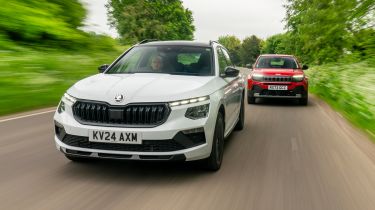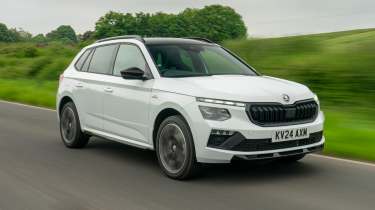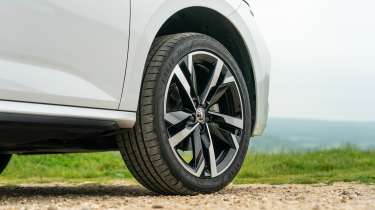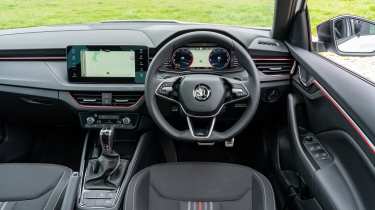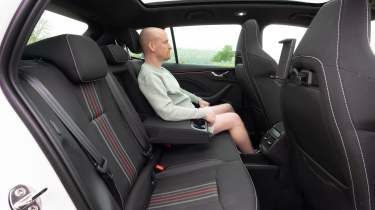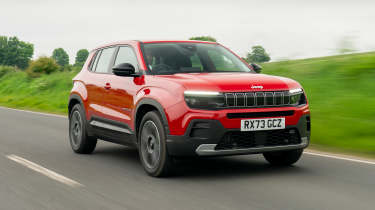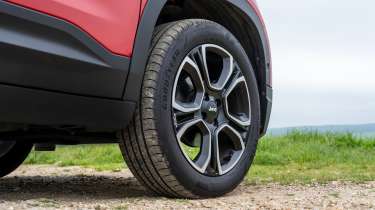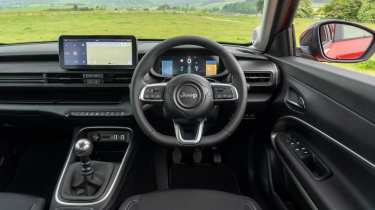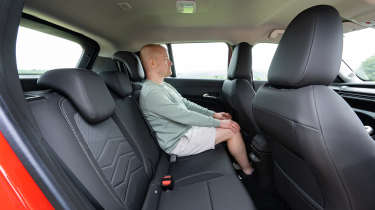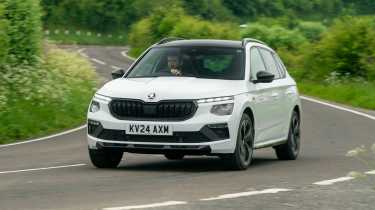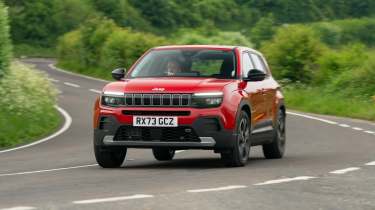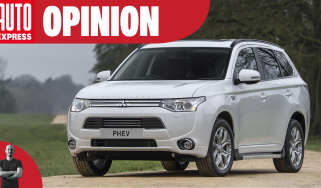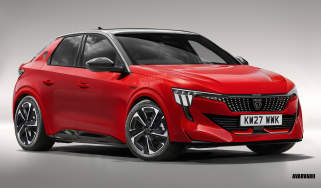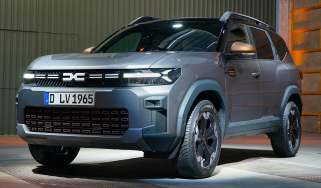Skoda Kamiq vs Jeep Avenger: which small SUV is mightiest?
The practical Skoda Kamiq takes on the stylish Jeep Avenger in a small petrol SUV battle
Small SUVs and crossover cars are the top of the pile right now when it comes to car sales in the UK. The most recent data from the Society of Motor Manufacturers and Traders shows that three of the top 10 best-selling cars in the UK so far this year are B-segment SUVs. If you include the slightly larger C-segment crossovers, it’s six out of 10.
Their popularity is easy to explain; they offer enough space for a wide range of buyers, they’re affordable to buy and run, yet manage to throw in a bit more style than the average hatchback.
One of the best of its type since it launched has been the Skoda Kamiq, thanks to its value- for-money ethos, spacious interior and grown-up handling. There’s now a newly refreshed model, which has a handful of cosmetic upgrades and some trim changes; essentially, the Czech brand hasn’t fixed what wasn’t broken. There’s also a genuine newcomer on the block in the shape of the Jeep Avenger. This model was previously electric only, but customer demand has justified that a petrol version of the smallest model in the Jeep range will be offered alongside the plug-in model.
We’ve brought the two of them together here to find out which small SUV is best – the tried-and-tested Skoda or the striking Jeep’s first venture into the petrol-powered compact class?
| Skoda Kamiq | Jeep Avenger | |
| Price: | £29,285 | £27,759 |
| Powertrain: | 1.0-litre 3cyl turbo, 114bhp, front wheel drive | 1.2-litre 3cyl turbo, 99bhp, front-wheel drive |
| 0-62mph: | 9.7 seconds | 10.6 seconds |
| Test efficiency: | 45.3mpg/10.0mpl | 47.0mpg/10.3mpl |
| CO2: | 126g/km | 127g/km |
| Annual VED: | £190 | £190 |
Skoda Kamiq
While the Skoda Kamiq in our pictures is a top-spec Monte Carlo model with a DSG automatic gearbox, we’re testing it as a manual in order to give the closest comparison to the Avenger. Like this, the Kamiq comes to £29,285 in its highest trim level, although the most affordable option with this engine, the SE, starts from £24,970.
Tech highlights
The Skoda sits on the VW Group’s MQB A0 architecture, so it shares many parts with the Volkswagen T-Cross and SEAT Arona. As with those models, and just like the pre-facelift car, the suspension comprises MacPherson struts up front and a torsion beam at the rear; it’s a very typical set-up for a car such as this.
The engine is a 114bhp 1.0-litre turbocharged three-cylinder petrol, so it has slightly more power than before. This engine is widely used across the VW Group, and produces 15bhp more than its rival here. However, its 200Nm of torque is actually 5Nm down on the Jeep’s motor.
The most notable changes for this facelifted car are cosmetic: there’s a bigger grille, sharper-looking lights and different bumpers to give it a fresher look. There’s also some underbody protection to give it a tougher image, although like the Avenger, the Kamiq is front-wheel drive only, so it won’t appeal to those planning to go off road. Drive is sent to the front wheels via a six-speed manual gearbox.
Safety: The Kamiq scored a five-star Euro NCAP rating in 2019, and the new car is fundamentally the same – although NCAP’s standards have become more stringent in the ensuing years. Lane-keep assist and autonomous emergency braking are both fitted as standard, but blind-spot assist comes as part of a pricey £1,030 option pack.
On the road
There's little to fault about the way the Kamiq drives. It’s comfortable, easy and predictable.
Around town: The Skoda’s punchy engine, light clutch pedal and smooth gearbox mean it’s very easy to drive in town. The suspension does a good job of soaking up smaller bumps, although bigger potholes cause a sharper thud than in the Jeep.
A & B-roads: Over bumpy roads, the suspension proves comfortable enough, but it’s not perfect. There’s still a slight harshness to the ride at higher speeds that can occasionally cause the interior plastics to rattle. This is par for the course in a small SUV, though; the cheaper, more basic suspension set-ups on models such as this mean they aren’t able to match the comfort of larger, more expensive SUVs.
The Skoda’s responsive engine and pleasant gearshift mean that it’s fun to drive on twisty roads, and the powertrain feels a lot more cohesive than the Jeep’s; it’s much easier to drive smoothly and accelerate quickly when you need to. There’s plenty of mid-range power, so you never need to rev the engine hard.
Road and wind noise aren’t an issue in the Kamiq and the engine is quiet at idle, although it does raise its voice with revs. It’s not an unpleasant-sounding engine, but the Jeep’s 1.2-litre motor is a little more characterful.
Motorway: The Kamiq is comfortable on the motorway, where smoother surfaces help to make it feel calmer and more relaxed than on a B-road. The engine note once again settles at a cruise, while decent high-speed stability means it feels like a larger car than it really is.
Ownership
The Skoda’s interior has had a minor update to keep it looking fresh, but the basic formula remains: it’s plain, but smart-looking and modern. The surfaces feel sturdy enough and while there are some hard plastics around, it feels more upmarket than the Jeep’s. It’s less characterful, though; some might even find it a bit dull. The huge panoramic sunroof fitted to our test car makes an otherwise black cabin feel much more open and airy, though.
Thankfully Skoda has kept its physical air- conditioning controls on the dashboard, so you can quickly flick between settings on the move without having to look away from the road. The switches are very easy to use and the buttons operate with a satisfying click, plus there are steering-wheel controls for the media system.
The seats are supportive in the Kamiq and there’s lots of adjustment available both in the chair and the steering wheel, so drivers of most builds should be able to find a comfortable driving position.
Storage: There are a pair of cup-holders beside the handbrake, with a small removable partition that is ideal for holding the key on the move. Further ahead, there’s a large box for your smartphone in front of the gear shifter. The door bins are a good size, with an enlarged section that can take a one-litre bottle. There’s also a little waste bin that slots into the driver’s door pocket, which is good for wrappers that you don’t want filling up the centre console.
Practicality
Despite its relatively compact dimensions, the Kamiq is among the more spacious cars in its class.
Rear Space: The Skoda is roomier than the Jeep in the back seats. There’s more leg and headroom, while the bench itself is a comfier shape for your back, and the headrests are better positioned, too. The rear Isofix points are very easy to access, which makes child seat installation easy.
Boot: With 1,395 litres of space when you fold the rear seats down, the Skoda is great for carrying larger items such as bikes and furniture when the need arises. The loading lip is a little high, but the wide opening means it should be easy enough to load in bulkier items and get them out safely when you arrive at your destination. Even with the seats up, there’s a generous 400 litres available, which is great for a car of this size.
What to buy?
Which version we’d choose...
- Engines: There are only two engines in the Kamiq range, this 114bhp 1.0-litre three-cylinder petrol and a 1.5-litre turbo petrol with four cylinders and 148bhp. That engine is smoother and more powerful while being only slightly less economical, so it’s a better choice if you can extend your budget. Manual and dual-clutch DSG automatic gearboxes are available for both engines.
- Trim: Three levels are available: SE, SE L and Monte Carlo. All get LED lights, dual-zone air-con and cruise control. SE L adds a better infotainment screen, while Monte Carlo gets sporty styling touches.
- Our choice: SE L is the sweet spot, with all the kit you need at a decent price.
Jeep Avenger
The Jeep Avenger is now available in three forms: fully-electric, hybrid or with a 1.2-litre petrol engine, a manual gearbox and front-wheel drive. We’re testing the latter here in top-spec Summit trim, which starts from £27,759.
Tech highlights
The Avenger has elements of the larger Renegade in its charming looks, but it’s hardly related to that car at all. The Renegade is based on the same platform as the Fiat 500X and came from the era before Peugeot and Citroen’s owner bought the Fiat-Chrysler stable of brands.
Now that Jeep is part of the Stellantis empire, the Avenger uses the same CMP platform that underpins the Peugeot 2008, DS 3, Vauxhall Mokka and a range of other small cars within the group. As with those models, it’s available with a 1.2-litre three-cylinder turbocharged petrol engine.
All of this means that the Avenger is more mainstream in feel than a lot of previous Jeeps. It’s front-wheel drive only in petrol form, so it’s not aimed at off-roading enthusiasts. It’s now just a regular SUV using the same formula as a Vauxhall Mokka – although that’s not a bad thing. The 99bhp turbo petrol engine uses a six-speed manual gearbox only, and its 205Nm of torque means it feels even punchier than the Skoda’s more powerful unit, although you’ll notice the Jeep’s relative shortage of power on the motorway.
Safety: The Avenger hasn’t been tested by Euro NCAP yet, but it comes with more safety kit as standard than its rival here, with a 360-degree parking camera, blind-spot assist and adaptive cruise control all included. Many of the cars
the Avenger is closely related to have achieved four-star ratings, so it’s not a stretch to predict a similar result when the Jeep is eventually assessed.
On the road
The Jeep isn’t quite as settled as the Skoda on tarmac. It also gets off-road driving modes to improve traction on difficult terrain, but it won’t turn the car into a Wrangler rival in the mud.
Around town: Although 99bhp doesn’t sound like much, a generous hit of low-down torque from the Jeep’s 1.2-litre turbo engine provides more than enough performance for daily driving. But the six-speed gearbox isn’t as slick as the Skoda’s, which is lighter and easier to use.
A & B-roads: The Avenger’s small petrol engine has very little inertia, which means it quickly loses revs when you dip the clutch to change gear. It makes it really tough to get a smooth shift unless you’re driving pretty slowly; rushed gearchanges cause the car to lurch clumsily. There’s also very little engine braking from the 1.2-litre unit, so changing down on steep hills achieves very little.
The engine is fairly noisy as you accelerate, but it quietens down nicely once you’re at a cruise. The Jeep also does a good job of dealing with harsh potholes, because the suspension soaks them up without too much crash into the cabin.
However, the Avenger isn’t as comfortable as the Skoda on rough roads, because it can’t keep steady over all the small bumps in the surface. The Jeep’s steering is as lifeless as the Kamiq’s but is also vaguer – particularly around the straight-ahead. And despite the apparent firmness to the ride, there’s a bit more body roll than in its rival.
Motorway: There’s little wind and road noise at speed, and the engine is quiet. Despite having only 99bhp, the Avenger rarely feels sluggish, either. The ride is still a little bumpier than the Skoda’s but the Jeep is comfortable enough on longer trips.
Ownership
We were impressed with the Jeep’s fuel efficiency on our test, because it achieved 47mpg over a wide mix of roads. On this and our many previous encounters with the Skoda, we achieved slightly less, although with a little over 45mpg on the cards, the savings over the course of 10,000 miles will be minimal – less than £20 a year. Neither car quite matched its claimed economy figures, but the Jeep was a bit closer and we found that on the motorway, over 50mpg was relatively easy to get.
The Jeep’s smart exterior looks are matched by its cabin, which is well designed, has plenty of character and looks nearly as upmarket as the Skoda’s. It’s only really let down by some hard, cheap-looking plastics in a few areas – the fake wood grain that spans the dash is unconvincing – but overall the Jeep’s dash looks interesting.
The air-con controls aren’t as easy to use as the Kamiq’s dials, but the Avenger does have physical toggle keys to operate these functions and a shortcut to the air-con system in the media display. It’s good enough to live with and the
row of switches below the screen looks smart.
There’s plenty of room up front, and even with a raised driving position, headroom won’t be an issue even for tall drivers. The pedals and steering are very light, which makes the Avenger nice and easy to drive daily. There’s a good amount of adjustment in the seat, and we didn’t get too uncomfortable on a longer trip in the Avenger, but the seats aren’t quite as soft and supportive as those in the Kamiq. The standard-fit adaptive cruise control works well and keeps things relaxed on the motorway.
Storage: While the electric version of the Jeep Avenger has a large cubby on the centre console, that space is needed for the gear shifter in this petrol version. There’s still enough space for a large smartphone in the central bin, with two USB ports and wireless charging available up front.
Practicality
The Jeep is barely any longer than a supermini on the outside, and that’s reflected in its interior cabin space, which lags behind its rival here.
Rear Space: A 157mm difference in overall length between these two – 94mm of which is within the wheelbase – really shows in the back of the Avenger, where it has significantly less room for passengers than the Kamiq. The main reason is a shortage of kneeroom, which is tight with taller occupants up front. Headroom is fine, though, so if you mainly intend to carry kids, it should be adequate.
Boot: The Jeep’s 380-litre boot is only a little smaller than the Skoda’s 400-litre space, and it expands to 1,277 litres with the rear seats folded. That’s smaller than the Skoda as well, although there’s a notch in the bumper that makes loading in heavy items easier, which is a nice touch.
What to buy?
Which version we’d choose...
- Engines: We’re testing the only Avenger in pure-petrol form, which is this 99bhp 1.2-litre 99bhp with a manual gearbox. There’s also a hybrid auto model, which costs around £2,000 more. You can also buy an all-electric version, which costs £10,000 more than our test car.
- Trim: Three versions are available: Longitude, Altitude and Summit. All come with LED lights, cruise control, lane keep assist and keyless entry. Mid-spec Altitude adds bigger wheels, a digital instrument cluster and adaptive cruise, while the top models get heated seats and a 360-degree camera.
- Our choice: Summit model is well equipped and beats the Skoda on value for money.
Results
Which car comes out on top?
Winner: Skoda Kamiq
The facelifted Kamiq is a fundamentally better car than its rival for its intended audience: it’s more comfortable, more practical and easier to drive than the Jeep, while also feeling more upmarket inside and bringing all the tech you could want for daily life.
Its slightly meagre standard-kit list means that you don’t get as much for your cash, but it balances that out with more performance, and no matter how much you pay, you can’t add a better ride or more interior space to the Jeep.
| Pros | Cons |
| Comfort | Low equipment levels |
| Practicality | Big bump harshness |
| Interior quality | No electrified powertrains |
| Infotainment tech | A little dull to drive |
Runner-up: Jeep Avenger
If you’re buying with your head, you’ll probably pick the more sensible Skoda here, but buyers will still fall for the Jeep’s stylish looks and pleasant interior, while the economical powertrain and generous equipment tick some sensible boxes, too.
The engine and gearbox aren’t as smooth and easy to use as the Skoda’s, but the Avenger makes good use of its modest power and is great around town. If space isn’t a priority for you, then it’s worth a look.
| Pros | Cons |
| Punchy engine | Fidgety ride on rough roads |
| Well equipped | Tight space in rear seats |
| Strong fuel economy | Tricky to drive smoothly |
| Competitive finance rates | Some cheap cabin plastics |
Rivals and other options
The Scala wins our test, but what else is out there?
- Same class: Citroen C3
- Same money: Ford Puma
- Used: Renault Captur
- Used: Volvo XC40
- Coming soon: Jeep Avenger 4xe
The great debate
The Auto Express team have their say…
John McIlroy, editor-at-large: “The Jeep’s engine is really punchy for a little three-cylinder motor. Don’t worry about it only having 99bhp, because it feels just as quick as the Skoda unless you really press it hard, and in cars like these, that’s something most drivers will do very infrequently anyway.”
Richard Ingram, deputy editor: “Despite its strong showing here, the Avenger is still better with electric motors under the skin than it is with a petrol engine. The ride is more settled, most likely because of the added weight of the battery, plus it’s quieter, more relaxing and just plain easier to drive.”
Jordan Katsianis, senior staff writer: “Skoda has kept the formula safe for this facelifted Kamiq. It’s certainly a slight improvement over the previous model, but if you want a Kamiq, then the most sensible option is to choose a used model. Little has changed, really, and the cheapest examples have dipped below £10k.”
Paul Barker, editor: “We love the Avenger’s style – its brilliant proportions look truly chunky, like all the best 4x4s should – but we’re split on some of its other quirks. Little touches such as the Jeep grille motifs on the wheels are fun, but some find that the drum & bass-style indicator noises can be tiring.”
Dean Gibson, senior test editor: “The Skoda emerged victorious here, but only just. Jeep’s competitive costs prove that the Kamiq is no longer the value proposition it was – and with that previously being a great strength, this update shows it’s no longer quite good enough to sit with the class leaders.”
Which would you buy? Let us know in the comments section below…
Specs and prices
| Skoda Kamiq 1.0 TSI Monte Carlo | Jeep Avenger 1.2T Summit | |
| On the road price/total as tested: | £29,285/£30,280 | £27,759/£27,759 |
| Powertrain | 3cyl in-line turbo petrol, 999cc | 3cyl in-line turbo petrol, 1,199cc |
| Peak power | 114bhp/5,500rpm | 99bhp/5,500rpm |
| Peak torque | 200Nm/2,000rpm | 205Nm/1,750rpm |
| Transmission | 6-speed manual/fwd | 6-speed manual/fwd |
| Fuel tank capacity | 50 litres | 44 litres |
| Length/wheelbase | 4,241/2,651mm | 4,084/2,557mm |
| Height/width | 1,531/1,793mm | 1,538/1,778mm |
| Boot capacity (seats up/down) | 400/1,395 litres | 380/1,277 litres |
| Kerbweight/payload/towing weight | 1,249kg | 1,180kg |
| Turning circle/spare wheel | 10.1 metres/£150 | 10.5 metres |
| Basic warranty (miles)/recovery | 3yrs (60,000)/3yrs | 4yrs (75,000)/4yrs |
| NCAP: Adult/child/ped./assist/stars | 96/85/80/75/5 (2019) | TBC |
| 0-62mph/top speed | 9.7 seconds/121mph | 10.6 seconds/114mph |
| Auto Express economy/range | 45.3mpg/498 miles | 47.0mpg/455 miles |
| Claimed economy | 49.2mpg | 48.7mpg |
| Actual/claimed CO2/tax bracket | 144/126g/km/30% | 139/127g/km/31% |
| Number of airbags/Isofix points | Six/two | Six/two |
| Parking sensors/camera | Rear/yes | Front & rear/360 degrees |
| Lane-keep assist/blindspot/AEB | Yes/£1,030*/yes | Yes/yes/yes |
| Climate control/adaptive cruise ctrl | Yes/£800* | Yes/yes |
| Leather/heated seats | No/£295* | £1,200/yes |
| Metallic paint/LED lights | £660/yes | £0/yes |
| Keyless entry & go/powered tailgate | £325*/£810* | Yes/yes |
| Sat-nav/digital dashboard/USBs | Yes/yes/four | Yes/yes/four |
| Online services/wireless charging | Yes/£350* | Yes/yes |
| Apple CarPlay/Android Auto | Yes/yes | Yes/yes |

